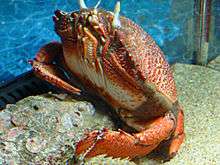Ranina ranina
| Ranina ranina | |
|---|---|
 | |
| Scientific classification | |
| Kingdom: | Animalia |
| Phylum: | Arthropoda |
| Subphylum: | Crustacea |
| Class: | Malacostraca |
| Order: | Decapoda |
| Infraorder: | Brachyura |
| Family: | Raninidae |
| Genus: | Ranina Lamarck, 1801 |
| Species: | R. ranina |
| Binomial name | |
| Ranina ranina (Linnaeus, 1758) | |
| Synonyms | |
| |

Ranina ranina, also known as the (red) frog crab or spanner crab,[1] is a species of edible crab,[2] found throughout tropical and subtropical habitats.[3] It is the only extant species in its genus.[4]
Description
It may grow up to 150 millimetres (5.9 in) long, and may weigh up to 900 grams (2.0 lb).[5] The carapace is wider at the front, reddish brown in color, with ten white spots.[3] Ranina ranina is mainly nocturnal, and remains buried in the sand during the day.[1] Ranina ranina is easily distinguished from other crab species in its habitat due to its red carapace and elongated midsection.[5]
Distribution and ecology
Spanner crabs inhabit coastal waters along the east coast of Australia, from Yeppoon in Queensland to the North coast of New South Wales. There is also a population to the north of Perth in Western Australia.[5] Ranina ranina is abundant in the coastal waters of south-western Mindanao, Philippines. These crabs are also found in the eastern coast of Africa, across the Indian Ocean to Indonesia, Japan and Hawaii and Vietnam.[6]
Ranina ranina inhabits depths of 10–100 metres (33–328 ft) on sandy-smooth substrata in which they bury themselves from where they attack small bottom-dwelling fish.[7] When waiting for prey, Ranina ranina will cover itself with sand, but leave its eye and mouthparts sticking out to help detect its food.[1] Offshore areas within this range in a subtropical or tropical environment serves as a habitat for Ranina ranina, but they must have ample sand for Ranina ranina to flourish, as covering themselves in sand is instrumental in their method of catching prey.
Fishery
The species is commercially exploited over much of its range, but the largest fishery is in Australia, where the annual commercial catch an estimated at 3,592 tonnes (7,919,000 lb).[3][8] In Queensland, only adults above 100 mm (3.9 in) carapace length may be landed.[9] In the Philippines in 2008, prices for Ranina ranina were around 200–300 pesos per kilogram.[3] Ranina ranina populations have been surveyed to avoid overfishing and are currently stable.[10]
Although Ranina ranina is a target of commercial fishing operations, little is known about the species' biology, population dynamics and ecology.[9] Attempts have been made to grow Ranina ranina in captivity, but have so far been met with little success.[1]
References
- 1 2 3 4 Phyu Phyu Than, Taizo Sakata, Kazuhisa Hamada & Keinosuke Imaizumi (1999). "Characteristics of dominant microflora in aquaculture tanks of juvenile red frog crab, Ranina ranina" (PDF). Memoirs of the Faculty of Fisheries: 1–6.
- ↑ S. L. Slattery, A. L. Ford & S. M. Nottingham (1992). "Cooking methods for spanner crabs Ranina ranina (L) and their effect on cadmium residues". Food Australia. 44 (5): 206–210.
- 1 2 3 4 Oliver D. Tito & Jonalyn P. Alanano (2008). "Some aspects of fisheries and biology of spanner crab (Ranina ranina, Linnaeus) in Maluso, Basilan Province, Philippines" (PDF). Memoirs of the Faculty of Fisheries: 40–48.
- ↑ Peter K. L. Ng, Danièle Guinot & Peter J. F. Davie (2008). "Systema Brachyurorum: Part I. An annotated checklist of extant Brachyuran crabs of the world" (PDF). Raffles Bulletin of Zoology. 17: 1–286.
- 1 2 3 "Spanner crab Ranina ranina". Fishing and Aquaculture. New South Wales Department of Primary Industries. 2005. Retrieved January 4, 2009.
- ↑ Juliana C. Baylon & Oliver D. Tito (2012) “Natural diet and feeding habits of the red frog crab (Ranina ranina) from southwestern Mindanao, Philippines” Philip. Agric. Scientist Vol. 95 No. 4, 391–398.
- ↑ Sydney Fish Market, “Species information: Spanner Crab” (2013) www.sydneyfishmarket.com
- ↑ Queensland Fisheries (2010) “Stock Status of Queensland's Fisheries Resources 2009-10” Queensland Australia: Queensland Department of Employment, Economic Development and Innovation. 65
- 1 2 J. M. Kirkwood, I. W. Brown, S. W. Gaddes & S. Hoyle (2005). "Juvenile length-at-age data reveal that spanner crabs (Ranina ranina) grow slowly". Marine Biology. 147 (2): 331–339. doi:10.1007/s00227-005-1574-0.
- ↑ J. McGilvray, I. Brown, E. Jebreen & D. Smallwood (2006) Fisheries Long Term Monitoring Program Summary of spanner crab (Ranina ranina) survey results: 2000-2005. Department of Primary Industries and Fisheries, Queensland, QI06095, Brisbane, Australia.